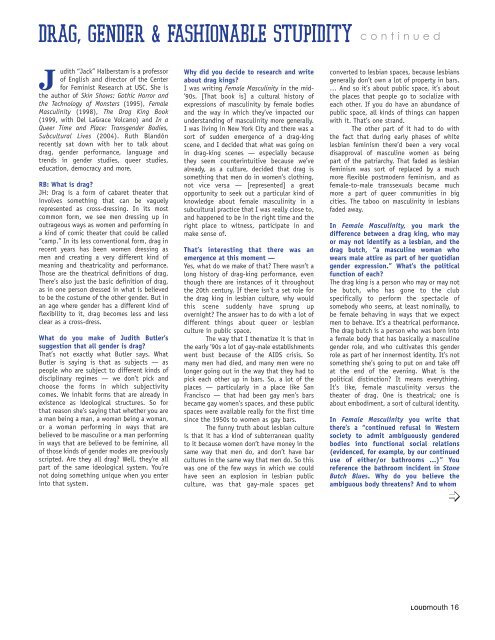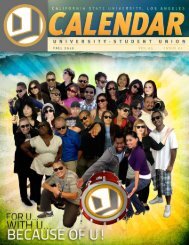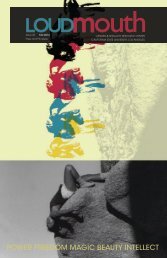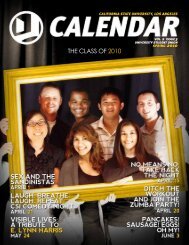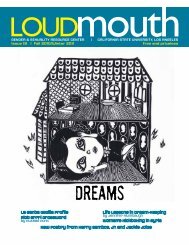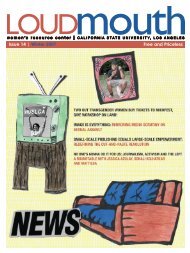judith “jack” halberstam on drag, gender and fashionable stupidity ...
judith “jack” halberstam on drag, gender and fashionable stupidity ...
judith “jack” halberstam on drag, gender and fashionable stupidity ...
You also want an ePaper? Increase the reach of your titles
YUMPU automatically turns print PDFs into web optimized ePapers that Google loves.
DRAG, GENDER & FASHIONABLE STUPIDITY c<strong>on</strong>tinued<br />
J<br />
udith “Jack” Halberstam is a professor<br />
of English <strong>and</strong> director of the Center<br />
for Feminist Research at USC. She is<br />
the author of Skin Shows: Gothic Horror <strong>and</strong><br />
the Technology of M<strong>on</strong>sters (1995), Female<br />
Masculinity (1998), The Drag King Book<br />
(1999, with Del LaGrace Volcano) <strong>and</strong> In a<br />
Queer Time <strong>and</strong> Place: Trans<strong>gender</strong> Bodies,<br />
Subcultural Lives (2004). Ruth Bl<strong>and</strong>ón<br />
recently sat down with her to talk about<br />
<strong>drag</strong>, <strong>gender</strong> performance, language <strong>and</strong><br />
trends in <strong>gender</strong> studies, queer studies,<br />
educati<strong>on</strong>, democracy <strong>and</strong> more.<br />
RB: What is <strong>drag</strong>?<br />
JH: Drag is a form of cabaret theater that<br />
involves something that can be vaguely<br />
represented as cross-dressing. In its most<br />
comm<strong>on</strong> form, we see men dressing up in<br />
outrageous ways as women <strong>and</strong> performing in<br />
a kind of comic theater that could be called<br />
“camp.” In its less c<strong>on</strong>venti<strong>on</strong>al form, <strong>drag</strong> in<br />
recent years has been women dressing as<br />
men <strong>and</strong> creating a very different kind of<br />
meaning <strong>and</strong> theatricality <strong>and</strong> performance.<br />
Those are the theatrical definiti<strong>on</strong>s of <strong>drag</strong>.<br />
There’s also just the basic definiti<strong>on</strong> of <strong>drag</strong>,<br />
as in <strong>on</strong>e pers<strong>on</strong> dressed in what is believed<br />
to be the costume of the other <strong>gender</strong>. But in<br />
an age where <strong>gender</strong> has a different kind of<br />
flexibility to it, <strong>drag</strong> becomes less <strong>and</strong> less<br />
clear as a cross-dress.<br />
What do you make of Judith Butler’s<br />
suggesti<strong>on</strong> that all <strong>gender</strong> is <strong>drag</strong>?<br />
That’s not exactly what Butler says. What<br />
Butler is saying is that as subjects — as<br />
people who are subject to different kinds of<br />
disciplinary regimes — we d<strong>on</strong>’t pick <strong>and</strong><br />
choose the forms in which subjectivity<br />
comes. We inhabit forms that are already in<br />
existence as ideological structures. So for<br />
that reas<strong>on</strong> she’s saying that whether you are<br />
a man being a man, a woman being a woman,<br />
or a woman performing in ways that are<br />
believed to be masculine or a man performing<br />
in ways that are believed to be feminine, all<br />
of those kinds of <strong>gender</strong> modes are previously<br />
scripted. Are they all <strong>drag</strong>? Well, they’re all<br />
part of the same ideological system. You’re<br />
not doing something unique when you enter<br />
into that system.<br />
Why did you decide to research <strong>and</strong> write<br />
about <strong>drag</strong> kings?<br />
I was writing Female Masculinity in the mid-<br />
’90s. [That book is] a cultural history of<br />
expressi<strong>on</strong>s of masculinity by female bodies<br />
<strong>and</strong> the way in which they’ve impacted our<br />
underst<strong>and</strong>ing of masculinity more generally.<br />
I was living in New York City <strong>and</strong> there was a<br />
sort of sudden emergence of a <strong>drag</strong>-king<br />
scene, <strong>and</strong> I decided that what was going <strong>on</strong><br />
in <strong>drag</strong>-king scenes — especially because<br />
they seem counterintuitive because we’ve<br />
already, as a culture, decided that <strong>drag</strong> is<br />
something that men do in women’s clothing,<br />
not vice versa — [represented] a great<br />
opportunity to seek out a particular kind of<br />
knowledge about female masculinity in a<br />
subcultural practice that I was really close to,<br />
<strong>and</strong> happened to be in the right time <strong>and</strong> the<br />
right place to witness, participate in <strong>and</strong><br />
make sense of.<br />
That’s interesting that there was an<br />
emergence at this moment —<br />
Yes, what do we make of that? There wasn’t a<br />
l<strong>on</strong>g history of <strong>drag</strong>-king performance, even<br />
though there are instances of it throughout<br />
the 20th century. If there isn’t a set role for<br />
the <strong>drag</strong> king in lesbian culture, why would<br />
this scene suddenly have sprung up<br />
overnight? The answer has to do with a lot of<br />
different things about queer or lesbian<br />
culture in public space.<br />
The way that I thematize it is that in<br />
the early ’90s a lot of gay-male establishments<br />
went bust because of the AIDS crisis. So<br />
many men had died, <strong>and</strong> many men were no<br />
l<strong>on</strong>ger going out in the way that they had to<br />
pick each other up in bars. So, a lot of the<br />
places — particularly in a place like San<br />
Francisco — that had been gay men’s bars<br />
became gay women’s spaces, <strong>and</strong> these public<br />
spaces were available really for the first time<br />
since the 1950s to women as gay bars.<br />
The funny truth about lesbian culture<br />
is that it has a kind of subterranean quality<br />
to it because women d<strong>on</strong>’t have m<strong>on</strong>ey in the<br />
same way that men do, <strong>and</strong> d<strong>on</strong>’t have bar<br />
cultures in the same way that men do. So this<br />
was <strong>on</strong>e of the few ways in which we could<br />
have seen an explosi<strong>on</strong> in lesbian public<br />
culture, was that gay-male spaces get<br />
c<strong>on</strong>verted to lesbian spaces, because lesbians<br />
generally d<strong>on</strong>’t own a lot of property in bars.<br />
… And so it’s about public space, it’s about<br />
the places that people go to socialize with<br />
each other. If you do have an abundance of<br />
public space, all kinds of things can happen<br />
with it. That’s <strong>on</strong>e str<strong>and</strong>.<br />
The other part of it had to do with<br />
the fact that during early phases of white<br />
lesbian feminism there’d been a very vocal<br />
disapproval of masculine women as being<br />
part of the patriarchy. That faded as lesbian<br />
feminism was sort of replaced by a much<br />
more flexible postmodern feminism, <strong>and</strong> as<br />
female-to-male transsexuals became much<br />
more a part of queer communities in big<br />
cities. The taboo <strong>on</strong> masculinity in lesbians<br />
faded away.<br />
In Female Masculinity, you mark the<br />
difference between a <strong>drag</strong> king, who may<br />
or may not identify as a lesbian, <strong>and</strong> the<br />
<strong>drag</strong> butch, “a masculine woman who<br />
wears male attire as part of her quotidian<br />
<strong>gender</strong> expressi<strong>on</strong>.” What’s the political<br />
functi<strong>on</strong> of each?<br />
The <strong>drag</strong> king is a pers<strong>on</strong> who may or may not<br />
be butch, who has g<strong>on</strong>e to the club<br />
specifically to perform the spectacle of<br />
somebody who seems, at least nominally, to<br />
be female behaving in ways that we expect<br />
men to behave. It’s a theatrical performance.<br />
The <strong>drag</strong> butch is a pers<strong>on</strong> who was born into<br />
a female body that has basically a masculine<br />
<strong>gender</strong> role, <strong>and</strong> who cultivates this <strong>gender</strong><br />
role as part of her innermost identity. It’s not<br />
something she’s going to put <strong>on</strong> <strong>and</strong> take off<br />
at the end of the evening. What is the<br />
political distincti<strong>on</strong>? It means everything.<br />
It’s like, female masculinity versus the<br />
theater of <strong>drag</strong>. One is theatrical; <strong>on</strong>e is<br />
about embodiment, a sort of cultural identity.<br />
In Female Masculinity you write that<br />
there’s a “c<strong>on</strong>tinued refusal in Western<br />
society to admit ambiguously <strong>gender</strong>ed<br />
bodies into functi<strong>on</strong>al social relati<strong>on</strong>s<br />
(evidenced, for example, by our c<strong>on</strong>tinued<br />
use of either/or bathrooms ...)” You<br />
reference the bathroom incident in St<strong>on</strong>e<br />
Butch Blues. Why do you believe the<br />
ambiguous body threatens? And to whom<br />
LOUDmouth 16


